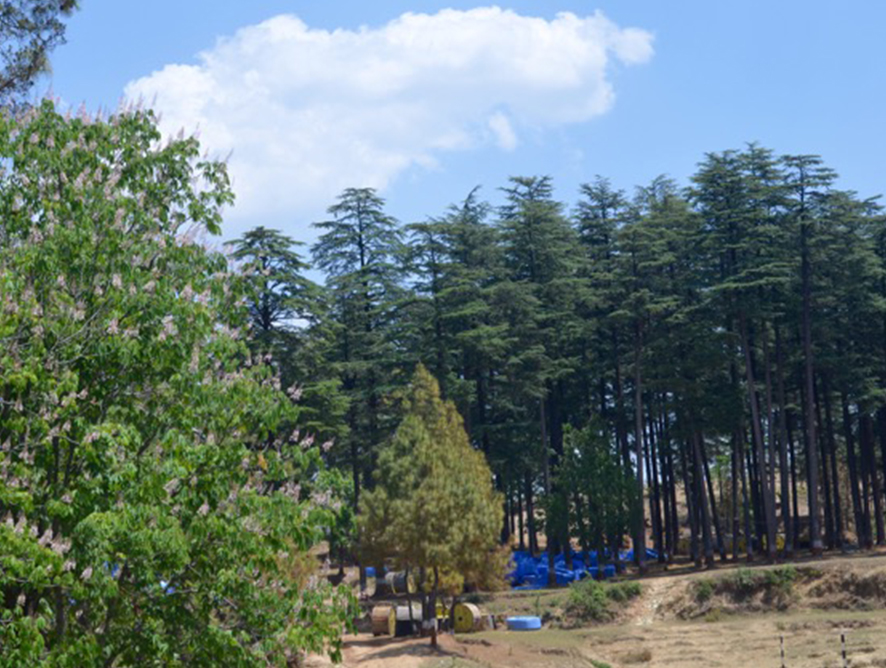Grey skies, rain filled clouds, moist forest slopes….the mountains are looking green and gorgeous in this summer month…today, actually.
Not too long ago, there was smoke, angry fires, loud media attention, fear and turmoil…the forest fires were raging, and they will rage again, as soon as the rains cease.
A lot of multi-faceted initiatives are being planned by well meaning organisations, people, government and others. When one thinks of the huge expanse of foothills and their forests, it is hard to see any impact being made by the efforts of a single well meaning human being…a drop in an ocean and all those phrases!
The one thing which can be done by any well meaning human being (count me in) is to plant a broad leaf tree, protect and nurture it for 5 years or more, shoo away cows and goats and welcome a patch of green in the midst of brown, pirul covered slopes.
This is the one thing which I will be doing, regularly, every year….Good, practical know-how and advice has come my way and I am documenting it right here. This can be used as a practical reference sheet by anyone who wishes to grow trees and foliage to counter the effect of the fast spreading pine trees.
- Native trees which grow best in the Himalayan foothills.
There is a lot of information available online and you can make your choice after reading up this site, discussing the matter with the local forest nursery, hill folks and neighbours.
In the lower foothills, consider saplings of Sal, Khair ( acacia), Harad, Baheda, Arjun and Sissoo ( sheesham/Indian rosewood)
For the higher reaches, Ranikhet included, look at Baanj ( oak), Kaafal ( Myrica rubra), Sharol ( Alder), Buransh ( Rhododendron).
- Dig a deep, deliberate pit.
Dig the pits well in advance..even 2-3 months before planting will be a good move.Digging early, besides ensuring aeration, will force any termites or Kurmule around that area, to move further away from the walls of the exposed, dug pit.
Choose the location with care. Rock formations, stream beds and human paths are best avoided.
Dig a pit that is minimum of 2x2x2 ( 8 square feet) or 3x3x3 ( 27 square feet)
- Prepare the PIT MIX
Prepare the local soil extracted from that very pit.The local soil will have a PH value and composition unique to that area, This helps avoid root shock for the roots when the plant’s roots reach the edges of the pit during a later stage in growth..
Many soils in our areas are laden with rocks/stones and these should be filtered out completely. Resistance to the root during growth hinders fast growth.
Use completely rotted cow dung manure from your local village.Be careful not to use fresh cow dung manure. Older the cow dung, better the manure.
Adding some bonemeal etc is a good idea. Aim to make the soil alkaline, especially if there are decomposing Pirul needles in the vicinity.
Ideally, your PIT MIX will be 1:1:1 ( local soil:rotted cow dung manure:bonemeal). A short cut would be 1:1;1.5.
TIP…you can reduce or eliminate Gobar Khaad by using Peat.
- Just before the monsoon rain arrives, fill the pit with the mixture.
Once you have put in the PIT MIX, just before the rain arrives, please wait and let it rain a few times. Now your pit is ready to accept the tree sapling.
- Always plant the sapling carefully.
Make sure you now dig out the right amount of PIT MIX, ensuring that the planting depth is right.
Ensure the sapling sits vertical in position.
Fill in the just removed PIT MIX around the saplings roots, gently pressing them down. Lay the existing roots right as you work your way up.
Once shut, press firmly down on the soil around the sapling, with the heel of your boots. Applying some pressure is good as the PIT MIX will be compacting itself further.
Nursery grown plants come in either plastic bags or in plastic pots.Removal of a tree sapling with some developed roots can be tricky. Gently remove the sapling from the plastic bag or pot. If the roots are netted, gently loosen them. If the composite used by the Nursery is clay, ensure that the roots are loosened a bit. Do not fiddle your way to the core of the root system.
- Water the planted tree well.If you have planted the sapling on a slope, ensure that you build a “mini ridge”around the pit that is 3 inches high,to retain more water, ie allowing future water to percolate right down to where it is needed.
Protect the sapling from grazing animals, frost, forest fires for the next 5 years.
This is the defining step for success. The planting is just the beginning of a long partnership, before the tree can hold its own against the elements, the animals and human beings. Keep a look out for the following nasties..
Grazing goats…they are liable to reach the top shoots of the growing tree. Once the top shoot has been eaten by a goat, the tree usually gives up on growth. Install tree guards or fencing, plant thorny bushes around the periphery of the sapling, and keep a sharp watchout for these perpetually hungry creatures.
Kurmule..

The bane of fruit growers and farmers in the hills. Found in fresh or half dried cowdung,these creatures look like caterpillars and have claws which eat up root systems. They do not like light, so are curled up. A delicacy for wild boars, who dig up fields of wheat and other plants to eat these, they will kill a promising sapling before your eyes.
Kill them by putting them in a mug of hot water. After that, leave them outside to become a protein rich meal for a bird.
So there…I have written down all the advice I have gleaned from local experts, farmers and people who want to save the forests.
Read it, use it, or just move on!

